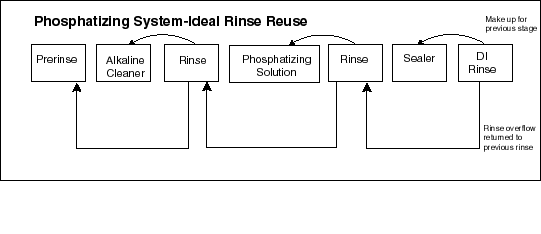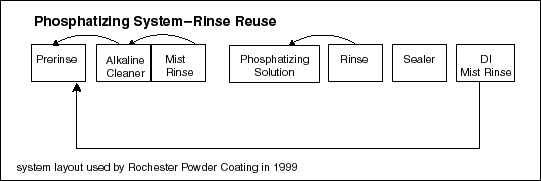
As the Minnesota Pollution Control Agency (MPCA) works to establish effluent phosphorus limits and phosphorus monitoring requirements for municipal treatment facilities, these facilities are looking to their industrial users to reduce phosphorus in their sewer discharge. Metal phosphatizing operations are a large industrial source of phosphorus in wastewater. When companies minimize phosphorus discharge from these operations they save by reducing chemical and water use.
Phosphatizing helps prevent corrosion and prepares the metal surface for improved paint adhesion. Less commonly, phosphatizing is used to improve the lubricity (slipperiness) of part surfaces. The phosphatizing process can vary widely. A spray wand is a simple one-stage cleaner/phosphatizer generally used on larger, low-volume products that do not require a high degree of corrosion resistance or adhesion. On the complex end are large, automated seven-stage conveyorized systems used for high volume component manufacturing and the highest surface property specifications. Three, five and six-stage systems are also common.
A typical system would start with alkaline cleaning then go through a rinse, phosphate coating, rinse and a seal rinse. For a medium-sized five-stage phosphatizing system, a five gallon-per-minute (gpm) rinse flow (600,000 gallons per year for one shift) is fairly typical. A greater flow rate may indicate an opportunity for decreasing water use.
Ideal Rinse Reuse
Modify an existing system. The following changes would have the greatest benefits :
Water and Chemical Use Reduction Tips
Reduce carryover. Keep the chemistries in their tanks by reducing carryover. Design parts for drainage by avoiding blind holes and recesses while designing in drain holes where possible. Rack parts for good drainage. Angle parts so that the solution drains off one point—not an edge—of the part back into the bath.
Design the system with adequate drip time. For dip tank operations, hold parts above the tank to allow solution to drain back into the tank. Holding parts above the tank for 15 to 30 seconds returns 40 to 50 percent of the dragout back into the tank.
Modify drain boards between stages to drain back to the previous stage. Multistage spray systems should have drain zones between stages that provide for similar drain times—15 to 30 seconds minimum. Consider a fine, low-volume mist arc or spray rinse between stages to remove more carryover.
Use clean water. Consider using deionized (DI) or reverse osmosis (RO) water for making up chemical baths and possibly for rinses. DI water greatly decreases the dissolved solids present which in turn lengthens the bath life and reduces the volume of chemicals used and discharged. Also it reduces the volume of sludge generated by treatment of wastewaters.
Automated systems. Ensure all process controls are properly set (i.e., speed, chemical additions) and that they are periodically calibrated and maintained. Conductivity controls are particularly sensitive—consider using inductive conductivity sensors to reduce maintenance requirements. Quality parts are not an indicator of good system control. Poorly maintained control systems can create quality products by overusing water and chemicals. Frequency of bath turnover may be a better indicator.
Water flow. Measure and control water flow. Flow meters give a quick indicator of water overuse and the malfunctions that lead to overuse. Metering valves can be used with flow meters to control flow rates. In the absence of flow meters, use flow restrictors to control flow. Always avoid using ball valves in water lines unless a wide open flow is desired. Small changes in ball valve position can result in large changes in water flow rate. Although cheap, they are appropriate only as on/off valves.
Filter baths. Remove solids that could build up in the tank or clog nozzles. Skim oil off the alkaline cleaning tank.
Spray nozzles. Clean spray nozzles. Plugged nozzles cause some areas of the parts to be poorly cleaned or coated. A common response to quality failures is to increase flows and the frequency of bath changes. Often just cleaning the nozzles would ensure that the solution cleans the parts. Properly position nozzles for an ideal spray pattern that ensures the solution cleans the parts.
Procedures. Train employees on proper operation of the phosphatizing system. Conduct daily inspection. Look for tank leaks, valve leaks, evidence of controller malfunctions and plugged nozzles.
Rochester Powder CoatingRochester Powder Coating (RPC), Rochester, Minnesota, is a job shop that paints sheet metal parts using powder coating. Prior to painting, the sheet metal goes through a phosphatizing line. By embracing pollution prevention practices, RPC reduced its phosphorus discharge by 98 percent over two years.
In October 1995, the discharge from the RPC phosphatizing system was 410 mg/L going into the City of Rochester’s sewer system. With impending phosphorus limits, RPC and the City of Rochester began to look for ways to reduce this phosphorus discharge. RPC implemented an aggressive approach to maximize the use of phosphate instead of discharging it. First, RPC began to monitor solution content every two hours. This ensured that the concentration was within the proper operating range so that they weren’t using too much or too little solution. They also added more-efficient spray nozzles to the phosphating risers which ensured that the solution reached the part and wasn’t wasted.
In 1995, RPC installed a five-stage cleaning/phosphatizing system, which includes alkaline cleaner, rinse, phosphatizing, rinse and sealer with a partial rinse return to the phosphating bath. This prevented loss of phosphorus by returning it to the bath to work some more. Along with installing this system, RPC instituted rigorous monitoring, maintenance and worker training. In 1997, a sixth stage, deionized (DI) rinse, was added to enhance corrosion resistance and recycle phosphate cleaning solution back for reuse in the mist rinse just prior to phosphatizing. This provides cleaner parts going into phosphatizing. Although RPC has increased its production and increased discharge by 30 percent, phosphorus discharge concentrations have been lowered to 8 mg/L.

Federal-Mogul Corporation
MnTAP funded a student intern at Federal Mogul, a manufacturer of diesel and compressor pistons and cylinder sleeves, to identify the sources of phosphorous in their manufacturing plant and to determine a strategy for reducing the quantity ending up in the wastewater. The two main sources of phosphorus were a phosphate coating process (96%) and plant maintenance cleaning chemicals (4%).
During the student’s time at the company, all of the cleaning chemicals were switched over to non-phosphorus containing materials. The substitutes performed as well as or better than the conventional phosphorous containing materials.
Changes to the phosphating line were suggested. They included typical actions like dragout reduction by having a lag time in transfer to the next step, fog-like rinsing, counter current flow in tanks. Also, procedures were recommended for more routine and careful maintenance of the baths to minimize chemical use and disposal, and to ensure that the proper coating quality was achieved. Approximately 50 percent of the total phosphorus from the process could be reduced with the above changes.
Hoffman Engineering CompanyHoffman Engineering Company, a manufacturer of metal and composite enclosures in Anoka, reduced water use in a painting pretreatment process with the help of a MnTAP intern. Three of the four washer stages were modified to conserve water. These changes resulted in estimated savings of $32,000 and 3.5 million gallons of water annually. Savings from decreased chemical use was not calculated.
Primarily by installing flow meters, automated conductivity meters and control valves, Hoffman gained better control of their bath concentrations and rinses. These changes helped them identify leaks and malfunctions as well as decreased the loss of bath chemicals. Drain zones were also modified to return more solution to each respective preceding stage.
Phosporus AlternativesHazardous waste sludge. If wastewaters from aluminum phosphatizing operations are treated and a sludge is produced that sludge is a listed hazardous waste [F019] and must be managed as one.
More InformationSources
1. Zheng, Haixing. An Alternative to Anodization: Sol-Gel Solutions for Metal Finishing. Metal Finishing, December 1998, 35.
2. Ault, Peter J. and Mike Starks. Abrasive Blasting as an Alternative to Chromate Conversion Coating on 5086 Series Aluminum. Metal Finishing, July 1999, 30-33.
3. Carpenter, Scott. One-Step, Zero-Effluent Organic Phosphating. Metal Finishing, September 1999, 56-60.
(10/99-64)